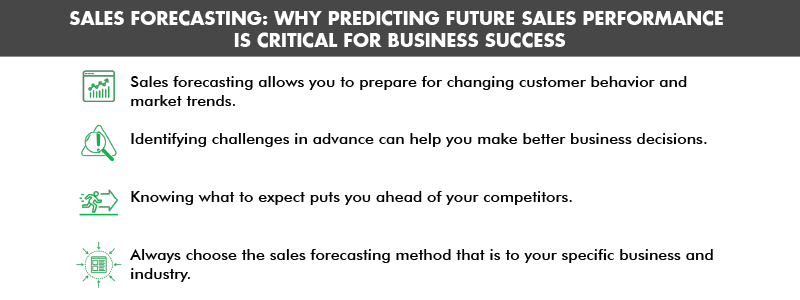Sales Forecasting: Why Predicting Future Sales Performance is Critical for Business Success

Sales forecasting can help you predict and solve problems before they happen, produce enough supply to deal with customer demand, and determine which marketing methods to use. Here’s how.

A sales forecast estimates how much your company will sell within a given period, usually quarterly or annually. It uses data such as market trends, historical sales, and customer behavior and analyzes them through tools like machine learning and qualitative assessments to predict future performance.
By examining the results from your sales forecast, you’ll be able to allocate resources correctly, plan marketing strategies, and improve your customer care. In this article, we’ll examine the importance of sales forecasting for your business and how you can develop an effective sales forecast. Let’s get into it.
Benefits of sales forecasting
If you're not using sales forecasting in your business, you're missing out on an opportunity to increase revenue and boost growth. Let's look at some benefits of sales forecasting.
Improved decision making
Through sales forecasting, you can make informed decisions about the essential aspects of your business such as recruiting, marketing campaigns, and inventory. For example, if you run a clothing company, sales forecasting can help you identify which clothes or designs are most popular, so you can choose which products to stock up on.
Better resource management
Because sales forecasting helps you predict future demand, you can allocate resources such as labor, finances, and materials without wastage. You can also prevent the issue of overstocking because you won’t be producing or purchasing above your estimated demand. Ultimately, a good sales forecast can help you save time and money.
Enhanced budget planning
Think of all the work that goes into budget planning. Accurate sales forecasting enables you to make precise estimates of your costs and revenue, making the budgeting process relatively stress-free. Your financial department can also use sales forecasting to plan investments, resource allocations, and expenses more accurately, which will reduce overspending.
Improved inventory management
Imagine you have orders to deliver and suddenly run out of stock. It can be frustrating for both your sales team and the customer. With sales forecasting, you can predict the demand and increase or decrease your stock accordingly. No more understocking or overstocking.
Increased sales and revenue
Sales forecasting also enables you to determine which pricing strategies will match the demand of your customers. For example, you can identify whether you should charge more or less to make more profit. In addition, sales forecasting helps you predict customer behavior. Hence you can tailor your products or services to suit customer needs, which will result in higher conversion rates and reduced losses.
As you can see, sales forecasting comes with an impressive share of benefits. But it’s not all smooth sailing.
Common challenges in sales forecasting
Sales forecasting can be challenging, especially if you’re just learning how to predict sales. Let’s explore some difficulties you’re likely to face.
Inaccurate data
Sales forecasting relies a great deal on historical data. And if this data is inaccurate, the results of your forecast will be wrong. For example, if you’re a new business owner, there may be insufficient historical data to guide your sales forecast. In such cases, you’re forced to rely on market research data, and if that data isn’t accurate, your projections won’t be, either.
Overoptimistic projections
It’s not uncommon for sales reps to make overoptimistic projections. After all, everybody wants to be a rock star. The problem is that inaccurate projections can lead to over budgeting, overpricing (or underpricing), and overstocking. Ultimately, you’ll be spending more money than is necessary to meet your customers’ demand, leading to a reduction in revenue and an inability to hit targets and milestones.
Ignoring market trends
One of the benefits of examining market trends is that it enables you and your sales team to make projections concerning customers’ current and future demands. Hence, you need to pay attention to these trends to make accurate predictions. Remember, accurate predictions are about more than just what your company has done in the past. You have to take a look at the bigger picture, as well.
Lack of expertise
Without a proper understanding of market trends, data analysis, and sales dynamics, you’ll end up with flawed projections, which is why training in sales forecasting is essential. It enables your sales team to gain skills that will help them gather accurate data, make decisions based on that data, and allocate resources effectively.
With those potential pitfalls in mind, it’s time to take a look at how to assemble an accurate sales forecast.
Steps to develop an effective sales forecast
Sales forecasting can help you expand your business, but only if you do it correctly. Luckily, the process is pretty straightforward.
Choose the right forecasting method
Keep in mind that there are different forecasting methods for various purposes. If you’re just getting started, it’s never a bad idea to pay attention to the methods that other businesses in your niche – especially your direct competitors – are using. While you may want to make some adjustments later, finding the standard for your industry is a good place to start.
Choose the right sales forecasting software
The right forecasting software should suit your business’s needs, leading to forecasts that apply to your operations. In addition, the software you choose should be able to integrate with your other sales tools, such as CRM software, to enhance your predictions.
Gather and analyze relevant data
You need to gather relevant data for your sales forecasting to be effective. Collecting and analyzing relevant data will help you set attainable goals and targets, make confident decisions, and formulate detailed plans to increase profit.
Once you’ve completed these three steps, you’re ready to start your forecasting journey – and remember that it’s just that. A journey.
Best practices in sales forecasting
The business world and market conditions are constantly evolving, so even the best sales forecasts aren’t set in stone. To ensure the continuing accuracy and relevance of your forecasts, follow these best practices.
Regularly review and update forecasts
Market trends, customer preferences, and economic factors are subject to change. Hence, it’s essential to review and update your sales forecasts regularly. Not checking your sales forecasts regularly can lead to inaccurate data and predictions.
Incorporate multiple perspectives
In sales forecasting, it’s essential to consider various angles. So feel free to bring in your sales, financial, and marketing teams to provide different perspectives and insights that can help your forecast.
Use real-time data
By studying data in real time, you can adjust your forecast (and your decision-making) to accommodate changes in customer behavior, industry trends, and spikes in demand.
Continuously refine the process
The sales process is constantly moving. Hence, you need to keep refining your sales forecasting methods if you want to have accurate results. Frequently check the accuracy of past predictions against actual results to identify any inconsistencies and find out the reasons behind them. With this information, you can modify your sales forecasting to ensure you’re producing more accurate results.
With these ideas in mind, you’re well on your way to producing an accurate and actionable sales forecast. But if all that seems a little overwhelming, it never hurts to call in the experts for an assist.
MetaGrowth can help
With thousands of hours of sales consulting experience, the team at MetaGrowth has the expertise you’re looking for. We can help get you up to speed on the latest sales forecasting techniques and train your staff to deliver the results you need to drive growth. Contact us today to discover how MetaGrowth can help take your sales efforts to the next level.
Written by
Josh Hirsch
